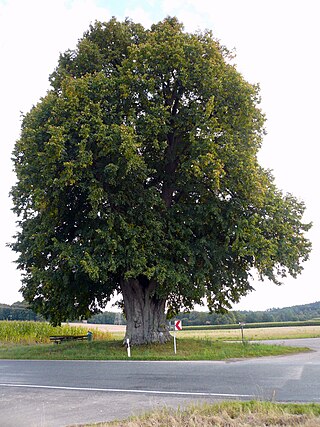
The Malvales are an order of flowering plants. As circumscribed by APG II-system, the order includes about 6000 species within nine families. The order is placed in the eurosids II, which are part of the eudicots.

Malvaceae, or the mallows, is a family of flowering plants estimated to contain 244 genera with 4225 known species. Well-known members of economic importance include okra, cotton, cacao, and durian. There are also some genera containing familiar ornamentals, such as Alcea (hollyhock), Malva (mallow), and Tilia. The genera with the largest numbers of species include Hibiscus, Pavonia, Sida, Ayenia, Dombeya, and Sterculia.

Bombacaceae were long recognised as a family of flowering plants or Angiospermae. The family name was based on the type genus Bombax. As is true for many botanical names, circumscription and status of the taxon has varied with taxonomic point of view, and currently the preference is to transfer most of the erstwhile family Bombacaceae to the subfamily Bombacoideae within the family Malvaceae in the order Malvales. The rest of the family were transferred to other taxa, notably the new family Durionaceae. Irrespective of current taxonomic status, many of the species originally included in the Bombacaceae are of considerable ecological, historical, horticultural, and economic importance, such as balsa, kapok, baobab and durian.

Tiliaceae is a family of flowering plants. It is not a part of the APG, APG II and APG III classifications, being sunk in Malvaceae mostly as the subfamilies Tilioideae, Brownlowioideae and Grewioideae, but has an extensive historical record of use.

Argyrodendron is a genus of mainly trees in the family Malvaceae. They occur in Malesia, New Guinea and Australia. In Australia, they are a well-known rainforest species known by their Indigenous Australian name, booyong or the tulip oak.

Sterculia is a genus of flowering plants in the mallow family, Malvaceae: subfamily Sterculioideae. Members of the genus are colloquially known as tropical chestnuts. Sterculia may be monoecious or dioecious, and its flowers unisexual or bisexual.

Tilioideae is a flowering plant subfamily in the family Malvaceae, though it was formerly considered a large group, placed at family rank and called Tiliaceae.

Malvoideae is a botanical name at the rank of subfamily, which includes in the minimum the genus Malva. It was first used by Burnett in 1835, but was not much used until recently, where, within the framework of the APG System, which unites the families Malvaceae, Bombacaceae, Sterculiaceae and Tiliaceae of the Cronquist system, the aggregate family Malvaceae is divided into 9 subfamilies, including Malvoideae. The Malvoideae of Kubitzki and Bayer includes 4 tribes:

Brachychiton rupestris, commonly known as the narrow-leaved bottle tree or Queensland bottle tree, is a tree in the family Malvaceae native to Queensland, Australia. Described by Sir Thomas Mitchell and John Lindley in 1848, it gained its name from its bulbous trunk, which can be up to 3.5 metres (11 ft) diameter at breast height (DBH). Reaching 10–25 metres (33–82 ft) high, the Queensland bottle tree is deciduous, losing its leaves between September and December. The leaves are simple or divided, with one or more narrow leaf blades up to 11 centimetres (4 in) long and 2 centimetres (0.8 in) wide. Cream-coloured flowers appear from September to November, and are followed by woody boat-shaped follicles that ripen from November to May. No subspecies are recognised.

Acropogon is a genus of flowering plants in the family Malvaceae. The genus is endemic to New Caledonia. It contains around 25 species. Its closest relatives are Australian genera: Argyrodendron, Brachychiton and Franciscodendron.

Herrania is a genus of flowering plants in the family Malvaceae, subfamily Byttnerioideae.

Dombeyoideae is a widely distributed subfamily of the Malvaceae, as proposed by the APG. Most of the plants placed here were once assembled with more or less related genera in the paraphyletic Sterculiaceae; a lesser number were placed in the Tiliaceae which were also not monophyletic.

Helicteres is a genus of flowering plants in the family Malvaceae. Its range is from tropical and sub-tropical Asia through to northern Australia, and also Mexico through to the northern half of South America.

Sterculioideae is a subfamily of the family Malvaceae containing evergreen and deciduous trees and shrubs.

Brachychiton gregorii, commonly known as the desert kurrajong, is a small tree of the genus Brachychiton found in northern and western Australia. It was originally classified in the family Sterculiaceae, which is now within Malvaceae.

Byttnerioideae is a subfamily of the flowering plant family Malvaceae.

Cola is a genus of trees native to the tropical forests of Africa, classified in the family Malvaceae, subfamily Sterculioideae. Species in this genus are sometimes referred to as kola tree or kola nut for the caffeine-containing fruit produced by the trees that is often used as a flavoring ingredient in beverages. The genus was thought to be closely related to the South American genus Theobroma, or cocoa, but the latter is now placed in a different subfamily. They are evergreen trees, growing up to 20 m tall, with glossy ovoid leaves up to 30 cm long and star-shaped fruit.
Durioneae is a tribe within the subfamily Helicteroideae of the plant family Malvaceae s.l. The tribe contains at least five genera, including Durio, the genus of tree species that produce Durian fruits.
Barbara Ann Whitlock is a botanist, who earned a Ph.D. from Harvard University, with her dissertation Systematics and evolution of chocolate and its relatives c. 2000, an interest which continues.


















